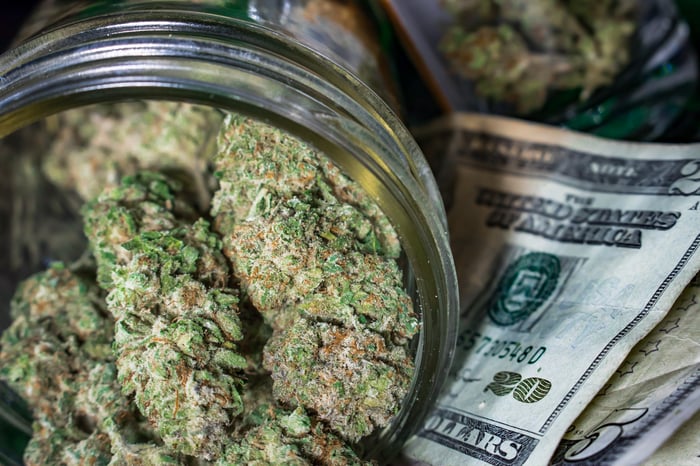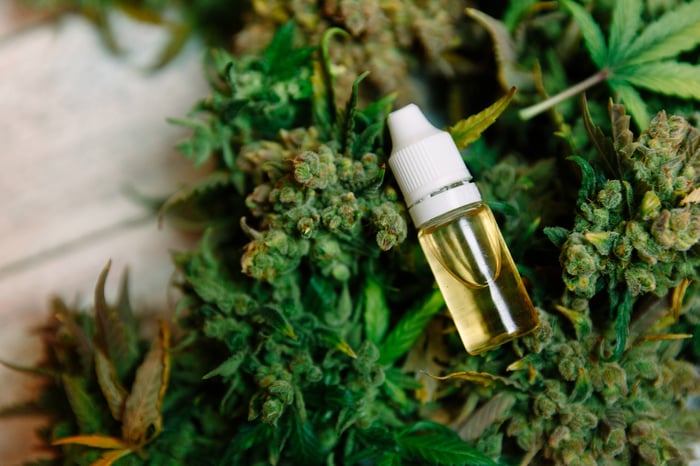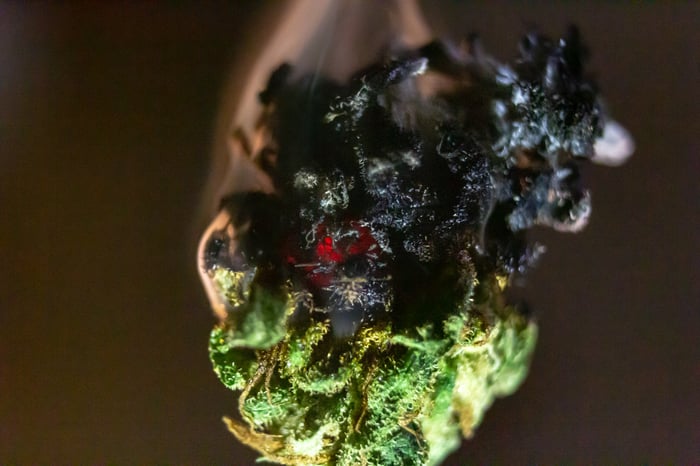"Ugly," "yuck," and "disappointment" are probably the first three words that come to mind when investors pore over the latest quarterly operating results from the marijuana industry's "Big Four" -- Canopy Growth (CGC 12.42%), Aurora Cannabis (ACB 8.92%), Cronos Group (CRON 4.45%), and Tilray (TLRY).
At this time last year, the expectation was that these Canadian cannabis giants would be pushing toward profitability amid strong sales growth. Unfortunately, reality has been far different. Supply issues stemming from Health Canada and select provinces have encouraged illicit production and created a supply bottleneck for growers, resulting in a number of unmistakably bad earnings reports.
Here's a rundown of how the Big Four fared after lifting their hoods for Wall Street this past week.

Image source: Getty Images.
Aurora Cannabis
Aurora Cannabis might be the most popular cannabis stock of the group, but its fiscal first-quarter operating results last Thursday, Nov. 14, were nothing short of a disaster. Despite reporting a stable gross margin of 58%, relative to the sequential fourth quarter, net sales came in at $75.2 million Canadian, a 24% sequential decline from Q4 2019. Consumer cannabis sales tumbled 33%, with lower-margin wholesale revenue nearly getting halved.
As you might imagine, this surprising decline in sales led to another big operating loss. Gross profit totaled CA$42.5 million before fair-value adjustments, while Aurora's operating expenses rose to CA$131.1 million. All told, Aurora Cannabis produced a CA$77.4 million operating loss inclusive of fair-value adjustments, which would have been closer to a CA$90 million operating loss without these adjustments.
What's more, Aurora Cannabis is changing up its game plan to better align with the challenges it's facing in its home market. Construction at both the flagship Aurora Sun and Aurora Nordic 2 facilities will cease immediately to conserve capital, with a grand total of 238,000 square feet of 1.62 million square feet of cultivation space expected to be used at Aurora Sun in 2020. In my best guess, this takes at least 320,000 kilos of Aurora's projected annual run-rate of 625,000 kilos by the end of June 2020 off the table for the time being.
And as the icing on the cake, Aurora continues to issue its stock like Monopoly money to raise capital and fund its operating activity. Aurora issued $124.4 million (that's U.S.) worth of stock during the latest quarter and now has 1.03 billion shares outstanding. That's up from just 16 million shares about five years ago.

Image source: Getty Images.
Canopy Growth
Canopy Growth, the largest marijuana stock in the world by market cap, also delivered its latest quarterly operating results on Thursday, albeit before the opening bell as opposed to after, as was the case with Aurora. Although gross revenue did increase 6% on a sequential quarterly basis (CA$118.3 million in Q2 2020 from CA$111.4 million in Q1 2020), Canopy wound up recognizing CA$32.7 million in sales adjustments -- e.g., returns, return provisions, and pricing allowances. Including another CA$9 million in excise taxes paid, Canopy's net sales fell to CA$76.6 million from CA$90.5 million in the sequential quarter.
Things get even worse when looking at Canopy Growth's costs, which keep soaring. Inclusive of these sales adjustments, the company's gross margin was minus-15%, with operating expenses ballooning another 15% to CA$269.4 million. In a true smack to shareholders' faces, share-based compensation rose to nearly CA$93 million. Put in another context, Canopy Growth issued more stock and options to employees than it generated in net sales! The company wound up losing CA$265.8 million from operations, and this includes a positive CA$13.1 million fair-value adjustment.
Furthermore, even without the free-spending former co-CEO Bruce Linton at the helm, Canopy saw its cash, cash equivalents, and marketable securities decline by CA$404.7 million during the fiscal second quarter. Mind you, Canopy does still have CA$2.73 billion at its disposal, as of the end of September but this is a far cry from the nearly CA$5 billion it had nine months ago. With Canada contending with serious supply problems and Canopy Growth slow to adjust its spending, this cash pile will likely continue to dwindle.

Image source: Getty Images.
Cronos Group
This past Tuesday, Nov. 12, before the opening bell, Ontario-based Cronos Group dished on its third-quarter operating results, which were considerably more subdued when compared, in hindsight, with Canopy and Aurora.
For the quarter, Cronos generated CA$12.7 million in net sales, which fell modestly short of Wall Street's expectations but was higher than what the company produced in the sequential second quarter. Cronos also wound up reporting a CA$788 million quarterly profit, albeit this was entirely the result of revaluing derivative liabilities tied to Altria Group's equity investment into the company. Once all of these one-time benefits and expenses are stripped out, you'd find a gross profit of CA$5.3 million, before fair-value adjustments, and operating expenses of CA$34.8 million.
The devil for Cronos Group was in the details. The company saw its net average per-gram sales price nearly get halved to CA$3.75 in Q3 2019. It's an odd situation, but with new supply from growers reaching the market, and few legal channels open in select provinces to facilitate sales, an oversupply of dried flower has developed, despite a huge black market presence. To boot, high-margin extract sales as a percentage of total revenue plunged to just 9%.
Also, like Aurora, Cronos Group announced plans to reduce operating expenses. It'll do this by repurposing some of its growing space at its flagship Peace Naturals campus for research and development, as well as the manufacture of derivatives. This means even less eventual peak output for Cronos.

Image source: Getty Images.
Tilray
Lastly, there's Tilray, which reported its third-quarter operating results after the closing bell on Tuesday. Keeping with its theme since going public in July 2018, Tilray once again missed Wall Street's loss-per-share consensus by a mile.
This latest quarter saw Tilray produce $51.1 million in gross sales (Tilray reports in U.S. dollars), and $48.2 million in net sales, after excise taxes. Like Cronos, this was a modest improvement over the $42.1 million in net sales recorded in Q2 2019. Despite an assortment of sprinkled-in positives, including a third consecutive quarter of gross margin improvement, Tilray still wound up losing $23.3 million on an operating basis, which also includes a $13.5 million acquisition-related benefit. Without this one-time benefit, the company's loss would have grown on a sequential quarterly basis.
Also like Cronos, Tilray saw its average sales price per gram fall through the floor. In Q3 2019, the company's average net selling price per gram was $3.25, down from $6.21 in the year-ago quarter and $4.61 in the sequential second quarter. Aside from supply challenges, Tilray points to "a shift in product and channel mix" for its lower average selling prices. This is a roundabout way of saying that higher-margin extracts didn't sell well, forcing the company to become even more reliant on dried flower.
As one final addendum, don't forget that Tilray has been forced to purchase wholesale marijuana to make up for its own lack of production. This is just another way the company's net sales price per gram has been adversely affected.
Long story short, the hope of a quick rebound from this recent hiccup in cannabis stocks is fading fast.





